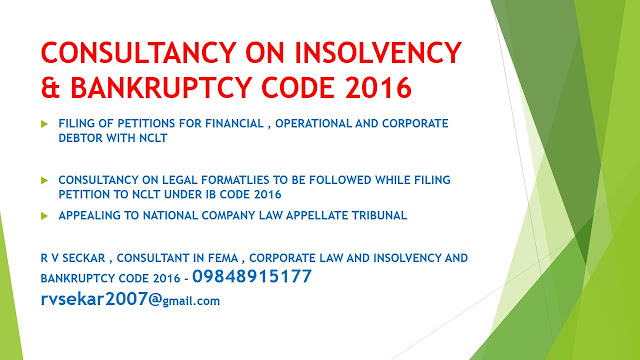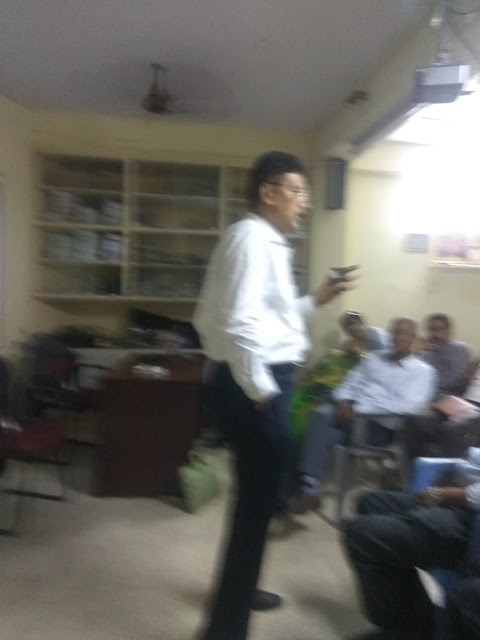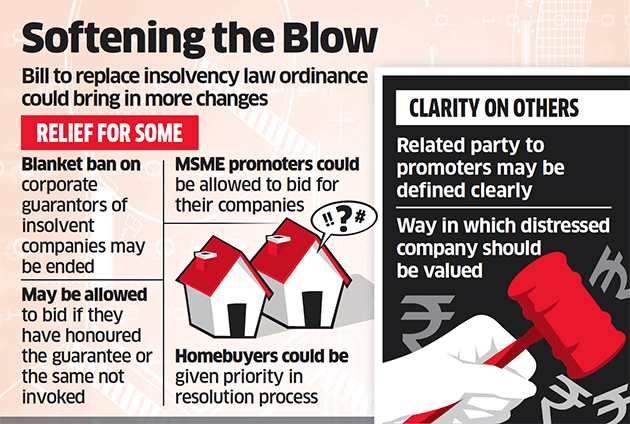An Insolvency Professional was suspended for one year
for the violation of IBC 2016 provisions.
In the matter of Ms. Bhavna Sanjay Ruia
ROLE OF INSOLVENCY PROFESSIONAL UNDER IBC 2016
An IP, as IRP / RP,
exercises the powers of Board of Directors of a corporate debtor undergoing
CIRP. He manages the affairs of the corporate debtor as a going concern. He is
the custodian of the property of the corporate debtor and protects and
preserves the value of such property. He conducts the entire CIRP and manages
the operations of the corporate debtor during the CIRP period. His
responsibilities during CIRP are detailed in the Code and relevant regulations.
He has similar onerous responsibilities in liquidation of corporate debtors,
and individual insolvencies and bankruptcies. These responsibilities require
highest level of standing, calibre and integrity which inspire confidence and
trust of the society and the stakeholders. In sync with the role of IPs under
the Code, the regulations provide for their capability and conduct and requires
an individual to be a fit and proper person for continuation of his registration
as an IP.
HEAVY FEES BY AN IRP IS NOT ACCEPTABLE
In this background, the DC finds that the conduct of Ms. Ruia is
unacceptable as explained hereunder: i) The fee (Rs.13.75 crore comprising IRP
fee of Rs.5 crore for the first one month and RP fee @ Rs.1.75 crore for five
subsequent months) contracted by Ms. Ruia is exorbitant and not reasonable
reflection of work to be done by her. It is unreasonable by any standard - in
relation to the compensation of the MD & CEO of the same corporate debtor,
fee of an IP for a similar CIRP, fee earned by Ms. Ruia as IRP / RP in a
similar CIRP, opportunity cost of time of Ms. Ruia, fee payable to a liquidator
of a similar corporate debtor, outstanding debt of Rs.4.16 crore of the
corporate debtor, etc. One
does not join the profession of IP to mint money from a distressed corporate
debtor at any cost. If the market has to bear such inexplicable costs
for a CIRP, it may look for other less costly options for resolution, defeating
the very purpose of the Code. The DC finds that Ms. Ruia has violated the
provisions of clauses 10, 24, 25 and 27 of the Code of Conduct for Insolvency
Professionals under the First Schedule of the Regulations and section 20 of the
Code.
NOT UNDERSTANDING THE CODE
ii) Ms. Ruia has demonstrated her inadequate understanding of the
law to the effect that
(a) the Code prescribes the fee of a liquidator;
(b) the fee of a liquidator is linked to book value of assets,
(c) the operational creditor appoints RP for CIRP and fixes his
fee;
(d) an IRP / RP meets the expenses of running the corporate debtor
as a going concern from his professional fee;
(e) an IRP / RP meets the expenses of CIRP from his professional
fee; (f) an IRP / RP needs to deploy additional staff as the existing personnel
of the corporate debtor do not cooperate and the Hon’ble Adjudicating Authority
does not hear matters for months,
(g) an IRP / RP engages
hundreds of personnel to run a corporate debtor; etc.
VIOLATION OF CLAUSE 10 OF THE IBC 2016
This poorly reflects on her competence as IP and lack of
understanding of the Code and the Rules and Regulations made thereunder. It is
doubtful if she can be entrusted with a CIRP given her level of knowledge and
understanding. The DC finds that Ms. Ruia has violated the provisions of clause
10 of the Code of Conduct for Insolvency Professionals under the First Schedule
of the Regulations.
ATTEMPT TO MISLEAD THE STAKEHOLDERS
iii) She has attempted to
mislead the stakeholders, the Board and the DC by a series of misrepresentation
of facts. A few examples are: a) She misled an operational creditor to sign
term sheet engaging her as RP and fixing her fees even before commencement of
the CIRP. b) According to the term sheet, her fee does not include the cost of
public announcement. She has now misrepresented that her fee includes the cost
of public announcement. c) According to the term sheet, her fee as IRP / RP is
exclusive of (a) professional fee for Valuers, Advocates, Solicitors, Forensic
Auditors, Consultants and Advisers, and (b) fee for representation before the
Hon’ble NCLT.
She has now misrepresented that her fee as IRP / RP includes
(a) fee for CA / CS
professional firms,
(b) fee for services of professional firms,
(c) fee for CA / professional representative for representation
before various tax authorities,
(d) fee for lawyers,
(e) fee for professionals,
(f) fee for project valuers, etc.
d) She has misrepresented
that she would meet all running expenses of the corporate debtor and all cost
of running the IRP from her fees.
e) Vide her submission dated 22nd March, 2018, Ms. Ruia stated
that professionals hired for specialised and critical operations shall be paid
by the corporate debtor as part of CIRP and routine staff, assistants and
supervisors appointed for the purpose of monitoring within the scope of her
duties shall be paid by her from her fees.
Vide her submission dated 21st April, 2018, she has misrepresented
that her fee as IRP / RP includes
(a) fee for CA / CS professional firms,
(b) fee for services of professional firms,
(c) fee for CA / professional representative for representation,
(d) fee for lawyers, (e)
fee for professionals,
(f) fee for project valuers, etc.
f) She computed the fee of a liquidator based on total assets of
Rs.6,861 crore while total assets of the corporate debtor is only Rs.2,761
crore. She computed fee of a liquidator based on book value while the law
required it to be computed
on realised value.
g) Ms. Ruia misrepresented the facts and situations and has not
been honest and straightforward in her professional dealings.
She has damaged the reputation of a fledging profession beyond
repair. Her conduct does not inspire confidence and trust of the stakeholders.
FINDINGS
The DC finds that she has violated the provisions of clauses 1, 2,
10, 12 and 24 of the Code of Conduct for Insolvency Professionals under the
First Schedule of the Regulations. iv) Ms. Ruia has admitted that she planned
for 6 or 9 months of CIRP. The term sheet provides for professional fee of Ms.
Ruia as RP. She took away the rights of the CoC to appoint an IP of its choice
as RP and fix his fees.
By misguiding an
operational to sign a term sheet, she compromised her independence and
attempted to jeopardise the interests of the CoC. The DC finds that Ms. Ruia
has violated the provisions of clauses 1, 2, 5, 10, 12, 24 of and 27 the Code
of Conduct for Insolvency Professionals under the First Schedule of the
Regulations. 5.3
Ms. Ruia has engaged in
acts that have brought disrepute to the noble profession of IP and severely
compromised her status as a fit and proper person. The overall conduct of Ms.
Ruia, as detailed above, is not unbecoming of an IP.
The DC concludes that Ms.
Ruia has contravened the provisions of clauses 1, 2, 5, 10, 12, 24, 25 and 27
of the Code of Conduct for Insolvency Professionals under the Insolvency and
Bankruptcy Board of India (Insolvency Page 9 of 9 Professionals) Regulations,
2016 read with regulation 7(2)(b) of the said Regulations and section 20 of the
Code. 6. Order 6.1
Ms. Ruia has repeatedly misled the stakeholders, the Board and the
DC. She has compromised her status as a fit and proper person and damaged the
reputation of the profession. Her conduct, which is violation of various
provisions of the law, as explained above, cannot be ignored.
The DC, however,
notes that Ms. Ruia is new to the insolvency profession and she has stated that
till date she has not undertaken any process under the Code. 6.2 Section 220(2)
and (3) of the Code read with regulation 11(8) of the Regulations empower the
DC to impose penalty as specified in sub-section (3) of section 220 or suspend
or cancel the registration of the IP.
Further, where any IP has contravened any provision of the Code or
rules or regulations made thereunder, the DC may impose a penalty which shall
be
(i)
three times the amount of the loss caused, or likely to have been
caused, to persons concerned on account of such contravention; or
(ii)
(ii) three times the amount of the unlawful gain made on account
of such contravention, whichever is higher and that where such loss or unlawful
gain is not quantifiable, the total amount of the penalty imposed shall not
exceed more than one crore rupees.
(iii)
In the instant case, the
Hon’ble Adjudicating Authority prevented Ms. Ruia from causing loss to others
or making unlawful gain. 6.3 Accordingly, the Disciplinary Committee, in
exercise of powers conferred under section 220 (2) of the Code read with
sub-regulation (8) of regulation 11 of the IBBI (Insolvency Professionals)
Regulations, 2016, hereby suspends the registration of Ms. Bhavna Sanjay Ruia,
Insolvency Professional [Registration No.
IBBI/IPA-002/IP-N00371/2017-2018/11065] for a period of one year.
(iv)
It sincerely expects that Ms. Ruia will use this one year to
strengthen her competency and ethical standards. 6.4 This Order shall come into
force on expiry of 30 days
from the date of issue of this order. 6.5 A copy of this order shall be
forwarded to the ICSI Institute of Insolvency Professionals where Ms. Ruia is
enrolled as a professional member.
For full order , please click the following link:















